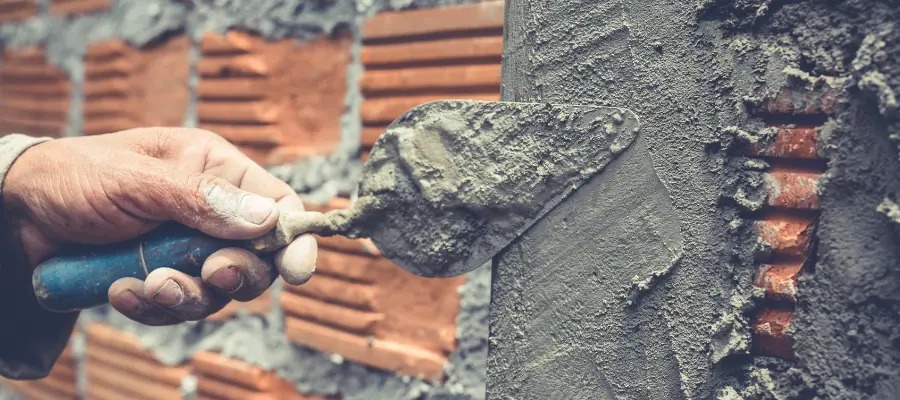Before starting the construction of your dream house, you will have many things in mind. When choosing building materials, cement is the most important. It is a binding material to concrete ingredients- sand and aggregates. Cement is a glue, acting as a hydraulic binder, which hardens when water is added.
So, which cement should you choose? Have you heard of Portland Slag Cement (PSC)? It’s becoming increasingly popular in the construction industry. PSC offers numerous advantages over traditional Portland cement, making it an excellent choice for sustainable and durable construction projects.
This blog of Brick & Bolt will let you explore this Portland slag cement’s uses, properties, and benefits, highlighting why it’s a better option for today’s construction projects.
What is Portland Slag Cement?
Portland Slag Cement(PSC) is a common type of cement. It is made by heating a mixture of limestone and clay in kilns at high temperatures to form pebble-sized materials known as clinker. This clinker is then finely crushed to generate Portland Cement. Portland cement blended with blast furnace slag is called Portland Slag Cement.
Properties of Portland Slag Cement:
Strength
Compared with ordinary Portland cement, PSC offers excellent strength in the short- and long-term strength.
Durability
PSC makes concrete structures last longer because they’re less likely to crack and, due to their permeability(let less water pass through).
Workability
PSC makes concrete easier to handle. It flows smoother, so pouring and finishing the concrete go much faster. This saves time and effort on the construction site.
Sustainability
PSC is eco-friendly because it uses recycled slag instead of brand-new materials. This cuts down on pollution caused by making those new materials and helps conserve resources.
Manufacturing of Portland Slag Cement

The following explains the process of production of Portland slag cement.
- Mixing the Base: The initial step involves grinding a mixture of materials typically found in rocks, such as lime, silica, alumina, and iron oxide.
- High–Heat Transformation: The finely ground mixture is then heated to very high temperatures in a large kiln. This intense heat produces a new material called “clinker,” which is a major part of PSC.
- The Final Mix: The clinker is then mixed with finely ground recycled glass-like materials commonly called “slag.” A small amount of gypsum is also added to adjust setting times. The proportion of slag can vary between 25% and 65% of the final PSC mixture.
The only ingredients in PSC are clinker, slag, and gypsum. The gypsum amount is also carefully controlled to ensure it works perfectly.
Features of Portland Slag Cement
- Strong and Long-Lasting: PSC makes concrete very strong, and it keeps getting stronger over time. This means buildings and roads made with PSC can last a long time.
- Durable: It stands up well against chemicals and other elements that can damage concrete, making it great for buildings that need to last in tough conditions.
- Less Heat: When PSC sets, it does not get as hot as regular cement. This is important for big construction projects because it helps prevent cracks.
- Easy to Work With: Concrete made with PSC is smoother and easier to shape, which is helpful for builders.
- Eco-Friendly: By using slag, PSC helps recycle industrial waste, which is better for the planet.
Uses of Portland Slag Cement
Portland Slag Cement can be used for many construction projects, including:
- Large Structures: It is great for building large structures like dams and bridges because they stay cool and strong.
- Coastal Buildings: PSC works well in places near the ocean because it resists saltwater damage.
- Roads and Bridges: It is a very good road and bridge constructor since it can withstand wear and tear.
- Precast Concrete: PSC is the material used to make pipes and blocks because it is sleek and feasible to work with.
Difference Between Ordinary Portland Cement and Portland Slag Cement
Here are some differences between ordinary Portland cement (OPC) and Portland Slag Cement (PSC):
| Feature | Ordinary Portland Cement (OPC) | Portland Slag Cement (PSC) |
| Composition | Made from clinker and gypsum | Contains clinker, gypsum, and slag |
| Heat of Hydration | Produces more heat | Produces less heat |
| Environmental Impact | Higher carbon emissions | Lower carbon emissions |
| Durability | Good | Better, especially in harsh conditions |
| Strength Development | Gains strength quickly | Gains strength slowly, but eventually becomes stronger |
| Resistance | Less resistant to chemicals | More resistant to chemicals |
What are the Applications of Portland Slag Cement?
PSC is applicable for a wide range of construction projects, along with
Mass Concrete
PSC has the special quality of low heat of hydration, which will minimize the risk of cracking in large concrete structures. So, it’s used in constructions like dams and foundations.
Marine Construction
Resistance to chloride attack is crucial when starting marine construction. PCS has this ideal property, so it’s used for ports, harbours , and other structures exposed to seawater.
Hydraulic Works
PSC is super durable, which makes it perfect for things like walls that hold back water, canals, and anything else that needs to be tough and long-lasting around water. Portland Pozzolana Cement (PPC) and Portland Slag Cement (PSC) are both hydraulic cements.
Precast Concrete Products
Because PSC is easy to work with and super strong, it’s ideal for making precast concrete items like pipes and slabs. These can be made quickly and last a long time.
What are the Benefits of Using Portland Slag Cement ?

Compared to other conventional types of cement, such as Portland pozzolana cement, Portland Slag Cement has the following benefits:
Environmentally Friendly
By using a byproduct of the steel industry, PSC reduces the carbon footprint in the building sector and promotes sustainable building practices and development by incorporating waste from the industry.
Economical
Portland Slag Cement uses less clinker and requires less energy to produce, so there will be considerable cost savings. Thus, it is a budget-friendly choice for construction projects.
Prolonged Lifespan
Structures built with PSC are resistant to cracking and chemical attacks. Thus, PCS concrete constructions are resistant to several kinds of deterioration and increase their durability. By expanding the construction’s service life, it will lower maintenance and repair expenses for a long time.
What are the Drawbacks of Portland Slag Cement?
PCS’s Setting Time is Slow
Compared with other traditional cement, PCS requires more setting and hardening time, which will impact project timelines. To conquer this issue, one should set proper planning for curing, scheduling, and other construction techniques.
Low Early Strength
PSC concrete takes a bit longer to get really strong at the initial curing period than other regular cement, but it catches up and becomes just as strong over time.
Mix Design
PSC concrete mixes might need a few adjustments compared to regular ones. This means using different amounts of water and potentially adding specific ingredients to get the perfect mix. To ensure everything’s perfect for your project, always check with a qualified engineer or best construction company like Brick & Bolt
Conclusion
Before initiating the construction of your home, it is important to understand the fundamental qualities of building materials. Portland slag cement (PSC) is an excellent option for modern construction because of its strength, durability, and ease of use. Additionally, PSC aids the environment by incorporating recycled materials. Although PSC takes slightly longer to set initially compared to regular cement, this can be managed with proper planning. Concrete mixes with PSC may also require some adjustments, but engineers can address these to ensure the success of your project.
FAQs
1. What is the difference between Portland Slag Cement (PSC) and Ordinary Portland Cement (OPC)?
Portland Slag Cement (PSC) is manufactured by grinding together Portland Cement clinker, gypsum and blast furnace slag, while Ordinary Portland Cement (OPC) is prepared by grinding together Portland Cement clinker and gypsum.
2. Is PSC stronger than OPC?
PSC has consistently higher long-term strength and durability than OPC because the hydration process of PSC is slower and the microstructure is more compact.
3. Is PSC more expensive than OPC?
The cost of PSC can vary depending on regional factors. But the cost is often compensated by advantages such as a longer service life of buildings and a smaller number of repairs and reinforcements.
4. How does the setting time of PSC compare to OPC?
PSC generally has a longer setting time compared to OPC. This extended setting time can be advantageous in certain construction applications, such as mass concreting and hot weather conditions, as it reduces the risk of cracking due to thermal stress. However, the initial setting time of PSC can be higher, which may require adjustments in project planning.
5. Does PSC require special handling or storage compared to OPC?
No, PSC does not require special handling or storage compared to OPC.

